sensor AUDI TT ROADSTER 2008 Owner's Manual
[x] Cancel search | Manufacturer: AUDI, Model Year: 2008, Model line: TT ROADSTER, Model: AUDI TT ROADSTER 2008Pages: 316, PDF Size: 70.1 MB
Page 162 of 316
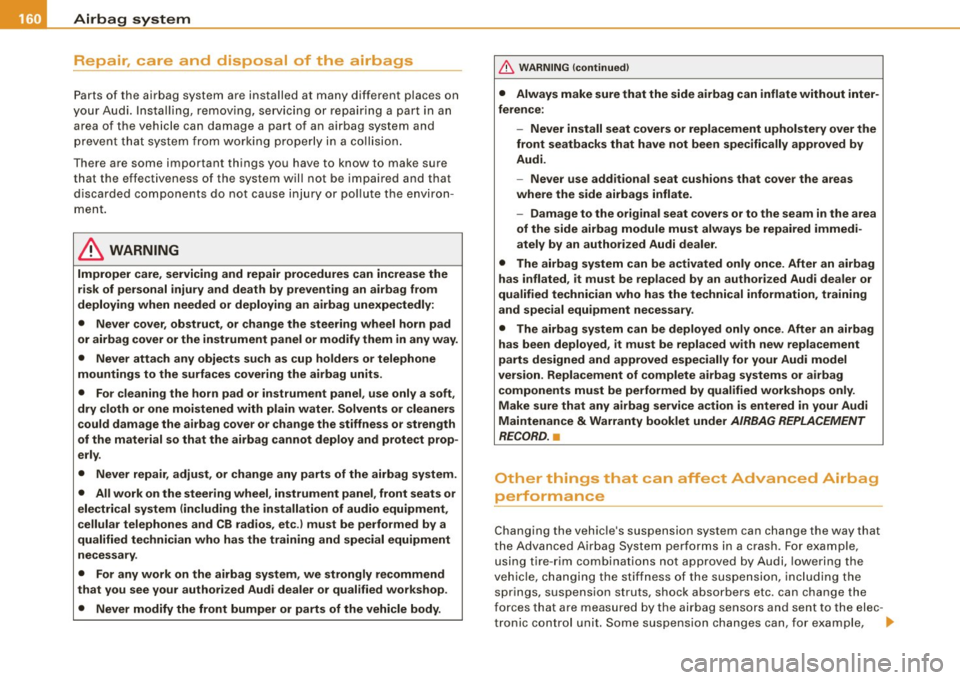
___ A_ ir_ b_ a-g _ s_y _s_ t_ e_ m _________________________________________________ _
Repair, care and disposal of the airbags
Parts of the airbag system are installed at many different places on
your Audi. Ins tal li n g, r em ovin g, s erv ic ing o r re pairi ng a part in an
area of the veh icle can damage a part of an a irbag system and
prev ent th at system from working pr oper ly in a c ollisio n.
There are some important things you have to know to make sure
that the effect ive ness of the system will not be impai red and that
discarded co mpone nts do not cause inju ry or po llute t he env iro n
ment .
& WARNING
Improper care , servicing and repair procedures can increase the
r isk of personal injury and death by preventing an airbag from
deploying when needed or deploying an airbag unexpectedly:
• Never cover , obstruct , or change the steering wheel horn pad
or airbag cover or the instrument panel or modify them in any way.
• Never attach any objects such as cup holders or telephone
mountings to the surfaces covering the airbag units.
• For cle aning the horn pad or instrument panel , use only a soft ,
dry cloth or one moi stened with plain water. Solvents or cleaners
could damage the airbag cover or change the stiffness or strength
of the material so that the airbag cannot deploy and protect prop
erly .
• Never repair , adjust , or change any parts of the airbag system.
• All work on the steering wheel , instrument panel, front seats or
electrical system (including the installation of audio equipment ,
cellular telephones and CB radios, etc .} must be performed by a
qualified technician who has the training and spec ial equipment
ne cessary .
• For any work on the airbag system , we strongly recommend
that you see your authorized Audi dealer or qualified workshop .
• Never modify the front bumper or parts of the vehicle body.
& WARNING (continued)
• Always make sure that the side airbag can inflate without inter
ference :
- Never install seat covers or replacement upholstery over the
front seatbacks that have not been specifically approved by
Audi .
- Never use addit ional seat cushions that cover the areas
where the side airbags inflate.
- Damage to the original seat covers or to the seam in the area
of the side airbag module must always be repaired immedi
ately by an authorized Audi dealer .
• The airbag system can be activated only once . After an airbag
has inflated, it must be replaced by an authorized Audi dealer or
qualified technician who has the technical information , training
and special equipment necessary.
• The airbag sy stem can be deployed only once . After an airbag
has been deployed , it must be replaced with new replacement
parts designed and approved especially for your Audi model
version. Replacement of complete airbag systems or airbag
components must be performed by qualified workshops only .
Make sure th at any airbag service action is entered in your Audi
Maintenance
& Warranty booklet under AIRBAG REPLACEMENT
RECORD .•
Other things that can affect Advanced Airbag
performance
Changing the vehic le 's suspension system can change the way that
th e A dva nced Ai rbag Sys te m p erform s in a c ras h. F or example,
using tire -rim combinations not approved by Audi, lowering the
ve hicle, c hanging the stiff ness of th e sus pensi on, in clud ing the
springs, suspens ion struts, shock absorbers etc . can chang e the
forces that a re measured by the airbag sensor s and sent to the e lec -
tronic control unit. Some suspension changes ca n, for example, .,_
Page 163 of 316
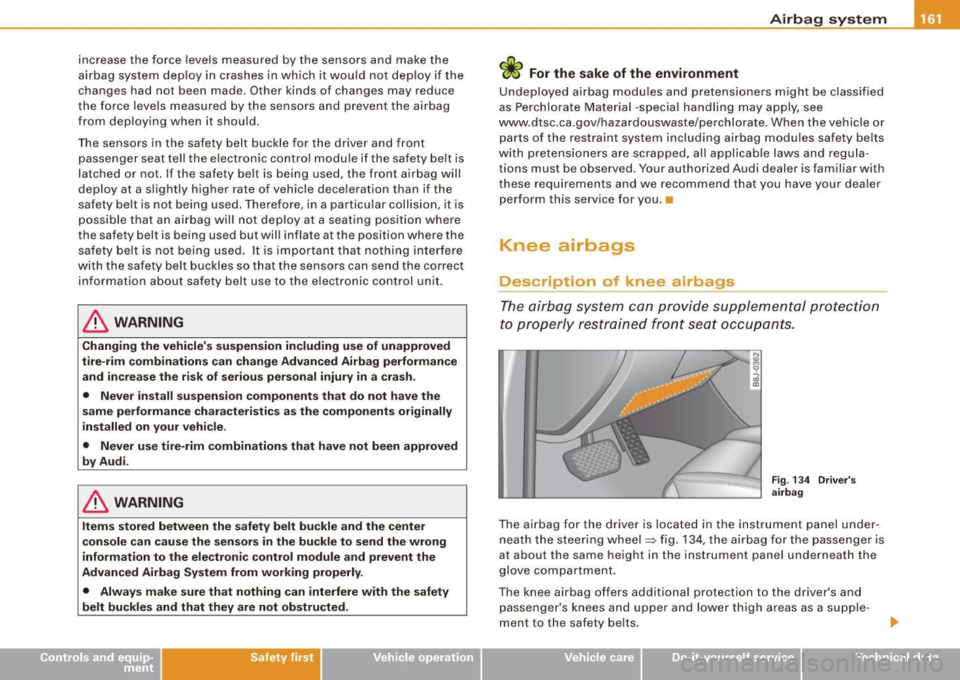
increase the force levels measured by the sensors and ma ke the
a irbag sy ste m d eploy in crashes in which it wou ld not deploy if the
changes had no t been made . Other kinds of changes may reduce
the force levels measured by the sensors and prevent the airbag
from deploying when it should.
The sensors in the safety belt buckle for the driver and front
passenger seat te ll the electronic control module i f the safety belt is
latched or not. If the safety belt is being used, the front airbag will
deploy at a sligh tly h igher rate of vehic le d ece leration than if the
safety belt is not being used. Therefore , in a particular co llision , it is
possible that an ai rbag will not deploy at a seating position where
the safety belt is being used but will inflate at the posi tion where the
safety belt is not being used . It is important tha t nothing interfere
with the safety belt buckles so t hat the sensors can send the co rrect
information about safe ty belt use to the elec tronic control unit.
& WARNING
Changing the vehicle's suspen sion including use of unapproved
tire -rim combinations can change Advan ced Airbag performan ce
and in crease the risk of serious personal injury in a cra sh.
• Never in stall su spen sion compone nts that do not have the
same performance characteristics as the components originally
in stalled on your vehi cle.
• Never use tire -rim combination s that have not been approved
by Audi.
& WARNING
Items stored between the safety belt bu ckle and the center
console can cau se the sen so rs in the buckle to send the wrong
inform ation to the ele ctron ic control module and prevent the
Advanced Airbag System from working properly .
• Always make sure that nothing can interfere with th e safety
belt buckle s and that they are not obstructed.
Safety first
Airbag sy ste m
ffi For the sake of the environment
Undeployed airbag modu les and pretensioners might be classified
as Perchlorate Material -specia l handling may apply, see
www.dtsc .ca.gov/hazardouswaste/perchlorate. When the vehicle or
parts of the restraint system including airbag modules safety belts
with prete nsioners are scrapped, all appl icable laws and regu la
tions must be observed . Your au thori zed Audi dealer is familiar wi th
t hese requirements a nd we rec ommend that y ou have your dea ler
perform this service for you. •
Knee airbags
Description of knee airbags
The air bag system can pr ovide supplemen tal pr otec tio n
to pro perly restrained fron t seat occupants.
Fi g. 13 4 D rive r's
airba g
The ai rbag for the driver is located in the instrument panel under
neath the steering wheel:=:, fig. 134 , the airbag for the passenger is
at about the same height in the instrum ent panel underneath the
glove compartment.
T he knee airbag offers add itional protection to the driver 's and
p assenger 's knees and upper and lower thigh areas as a supple -
ment to the safety belts . •
Vehicle care I I irechnical data
Page 167 of 316
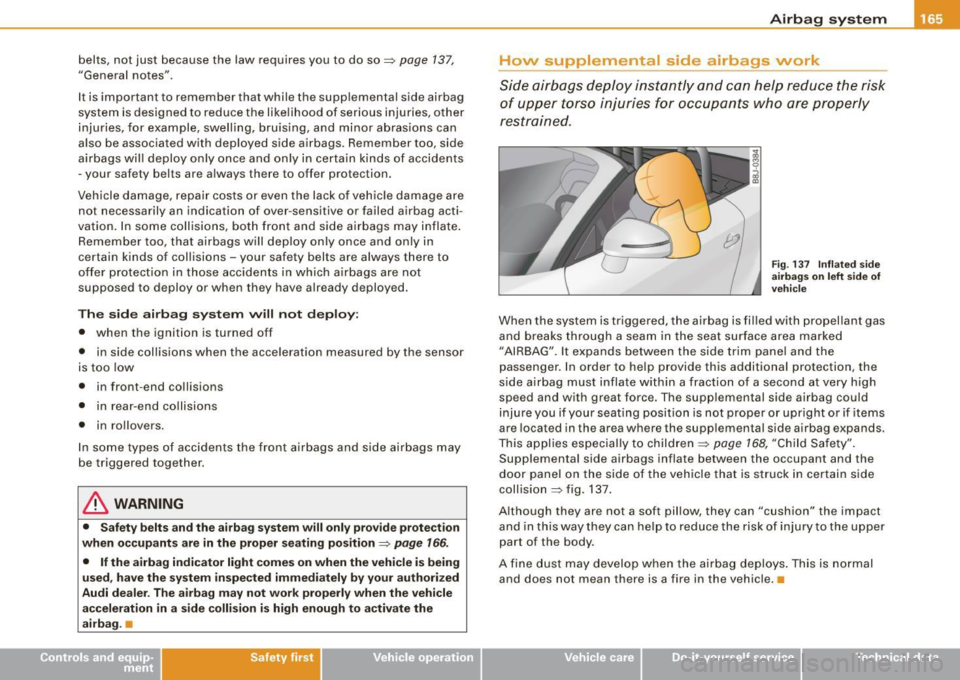
belts, not just because the law requires you to do so=> page 137,
"General notes" .
It is important to remember that while the supplemental side airbag
system is designed to reduce the likelihood of serious injuries, other
injuries, for example, swelling, bruising, and minor abrasions can
also be associated with deployed side airbag .s. Remember too, side
airbags wil l deploy only once and on ly in certain kinds of accidents
- your safety belts are a lways there to offer protection.
Vehicle damage, repair costs or even the lack of vehicle damage are not necessarily an indication of over -sensitive or failed airbag acti
vation. In some collisions, both front and s ide airbags may inflate .
Remember too , that airbags will deploy only once and only in
certain kinds of collisions - your safety belts are always there to
offer protection in those accidents in which airbags are not
supposed to deploy or when they have already deployed .
The s ide a ir ba g sy stem will not dep loy:
• when the ignition is turned off
• in side coll isions when the acce leration measured by the sensor
is too low
• in front -end collisions
• in rear -end collisions
• in rollovers.
In some types of accidents the front airbags and side airbags may
be triggered together.
& WARNING
• Safet y belt s a nd the airbag sy stem will only provid e prote ct ion
w hen o ccupants ar e in the proper s eating p osition
=> page 16 6.
• If the airbag indicat or light come s on when the vehicle i s being
u sed , have the system in sp ec ted imm ediatel y by your authori zed
Audi de aler . Th e airb ag m ay not work properly when the vehicle
a ccel era tion in a side c olli sio n is high enough to a ctiv ate th e
airb ag .•
Safety first
Airbag sy ste m
How supplemental s ide airbags work
Side airbags deploy instantly and can help reduce the risk
of upper torso injuries for occupants who are properly
restrained .
Fig. 137 Infl ate d side
airb ags on left sid e o f
ve hicle
When the system is triggered , the airbag is fi lled with propellant gas
and brea ks through a seam in the seat surface area marked
"AIRBAG" . It expands between the side trim pane l and the
passenger. In order to help provide this additional protection, the
s ide a irbag must inflate within a fraction of a second at very h igh
speed and with great force. The supp lemental side airbag could
injure you if your seat ing position is not proper or upright or if items
are located in the area where the supplemental side airbag expands.
This applies especially to children =>
page 168, "Child Safe ty" .
Supp lemental side airbags inflate between the occupant and the
door panel on the side of the vehicle that is struck in certain side
collision=> fig. 137.
Although they are not a soft pillow, they can "cushion" the impact and in this way they can help to reduce the risk of injury to the upper
part of the body .
A fine dust may develop when the airbag deploys . This is normal
and does not mean there is a fire in the vehicle. •
Vehicle care I I Technical data
Page 169 of 316
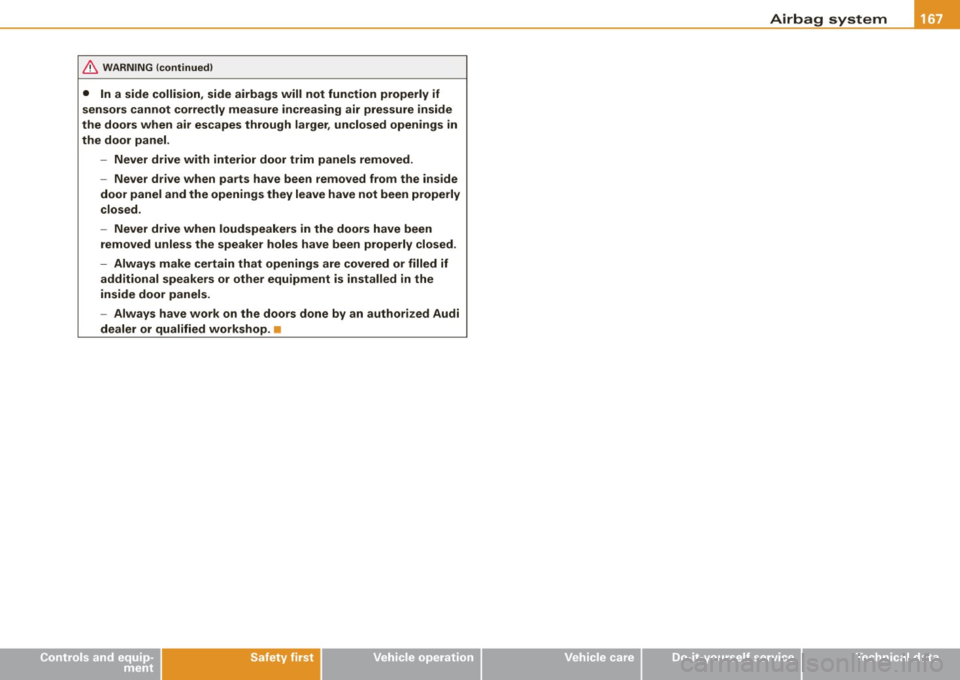
__________________________________________________ A_ i_ r _b _a...; g::- s_ y=--- s_t _e _m __ ,n
& WARNING (continued)
• In a side collision, side airbags will not function properly if
sensors cannot correctly measure increasing air pressure inside
the doors when air escapes through larger, unclosed openings in
the door panel.
-Never drive with interior door trim panels removed.
- Never drive when parts have been removed from the inside
door panel and the openings they leave have not been properly
closed .
- Never drive when loudspeakers in the doors have been
removed unless the speaker holes have been properly closed.
- Always make certain that openings are covered or filled if additional speakers or other equipment is installed in the
inside door panels.
- Always have work on the doors done by an authorized Audi
dealer or qualified workshop. •
Controls and equip ment Safety first
Vehicle operation Vehicle care Do-it-yourself service Technical data
Page 171 of 316
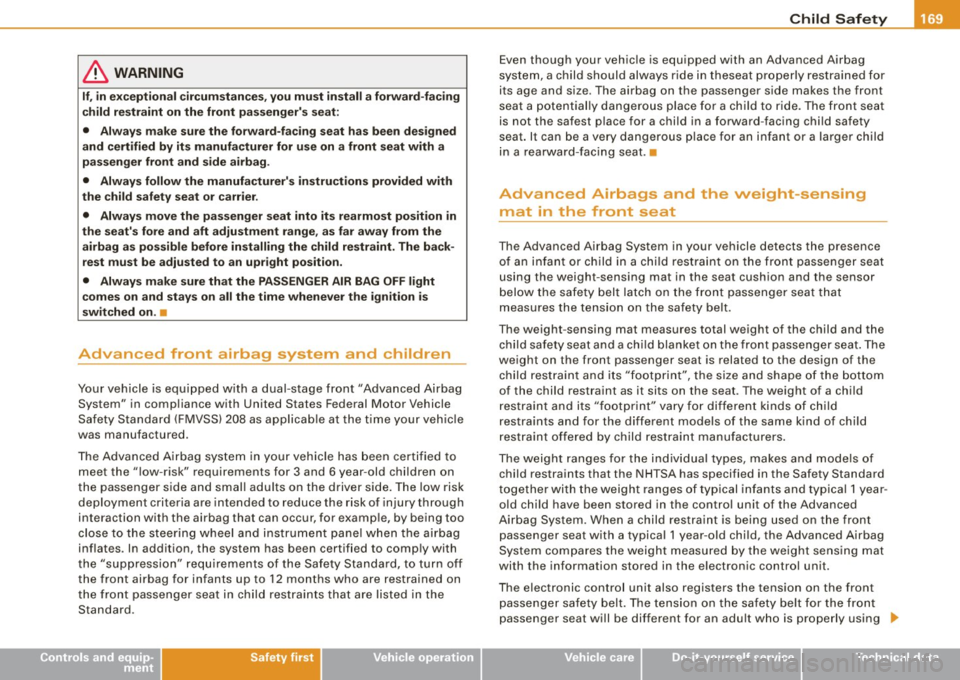
_____________________________________________ C_ h _ il_d _S_ a _ fe_t.....: y'----""
& WARNING
If , in e xceptional circum sta n ce s, y ou mu st in stall a forward -fa cing
c hild re straint on the front pa ssenger' s seat:
• Always m ake sure the forw ard-f acing se at has b een de signed
and cert ified by it s manufa cturer for use on a front seat with a
p ass eng er fro nt and side airbag .
• Alwa ys follow the manufacturer' s instruc tion s provided with
the child s afet y seat or carrier .
• Alway s move the p assenger sea t into it s rearmo st po sition in
the seat's fore and aft adjustme nt r ange , as far a way from the
airbag as po ssible before in stalling the child restraint. The ba ck
rest must be adju sted to an upr ight p osition .
• Alway s m ake sure th at the PASSEN GER AIR BA G OFF l ight
c ome s on and stay s on all the time wheneve r the ignition is
s witched on. •
Advanced front airbag system and children
Your vehicle is equipped with a dual-stage front "Advanced Airbag
System" in comp liance with United States Federal Motor Vehicle
Safety Standard (F MVSS) 208 as applicab le at the t ime your vehic le
was manufactured .
The Advanced Airbag sys tem in yo ur vehicle has been cer tified to
meet the "low -risk" requirements for 3 and 6 year -old children on
the passenger side and small adults on the d river side. The low risk
deployment criteria are intended to reduce the risk of injury through
interaction with the airbag that can occur, for examp le, by being too
close to the steering wheel and instrument pane l when the airbag
inflates . In addition, the system has been certified to comp ly with
the "suppression" requirements of the Safety Standa rd, to turn off
the front airbag for infants up to 12 months who are restrained on
the front passenger sea t in child restraints that are listed in the
Standard .
Controls and equip
ment Safety first Vehicle operation
Even though your vehicle is equipped with an Advanced Airbag
system, a child should always ride in theseat pr operly restrained for
its age and size. The airbag on the passenger side makes the front
seat a potentially dangerous place for a child to ride. The front seat
is not the safest place for a child in a forward -facing child safety
seat . It can be a very dangerous p lace for an infant or a larger child
in a rearward -facing seat. •
Advanced Airbags and the weight -sensing
mat in the front seat
The Advanced A irbag System in your vehicle detects the presence
of an infan t or child in a chi ld rest rain t on the front passenger seat
using the weight -sensing mat in the seat cushion and the sensor
below the safety belt latch on the front passenger seat that
measures the tension on the sa fety belt.
The weight -sensing mat measures total weight of the child and the
child safety seat and a chi ld blanke t on the front passenger seat . The
weight on the front passenger seat is related to the design of the
child res tra int a nd i ts "footprin t", the size and shape o f the b ottom
of the child restraint as it sits on the seat . T he weight of a child
restra in t and its " footprint" va ry for different kinds of ch ild
restraints and for the different models of the same kind of chi ld
restraint offered by child restraint manufacturers .
The weight ranges for the ind ividual types, makes and models of
child restraints that the NHTSA has specified in the Safety Standard
t ogether with the weight ranges of typical infan ts and typica l 1 year
old chi ld have been stored in the control unit of the Advanced
Airbag Sys tem. When a child res traint is being used on the front
passenger seat with a typical 1 year-old chi ld, the Advanced Airbag
System compares the weight measured by the we ight sensing ma t
with the information stored in the e lectronic control unit.
The electronic contro l unit also registers the tension on the front
passenger safe ty bel t. The tension on the safety be lt for the front
passenger seat will be different for an adult who is properly using •
Vehicle care Do-it-yourself service Technical data
Page 172 of 316
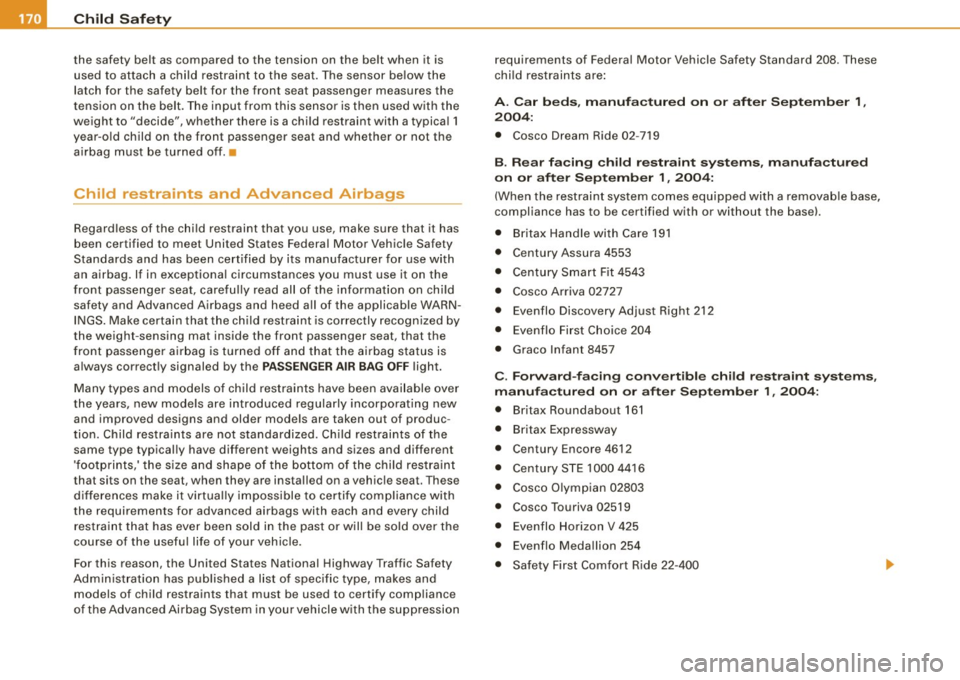
___ C_ h_ il_ d _S_ a_fe _ ty ______________________________________________ _
the safety belt as compared to the tension on the belt when it is
used to attach a child restraint to the seat. The sensor below the latch for the safety belt for the front seat passenger measures the
tension on the belt. The input from this sensor is then used with the
weight to "decide", whether there is a child restraint with a typical 1
year-old child on the front passenger seat and whether or not the
airbag must be turned off. •
Child restraints and Advanced Airbags
Regardless of the child restraint that you use, make sure that it has
been certified to meet United States Federal Motor Vehicle Safety
Standards and has been certified by its manufacturer for use with
an airbag. If in exceptional circumstances you must use it on the
front passenger seat, carefully read all of the information on child
safety and Advanced Airbags and heed all of the applicable WARN
INGS. Make certain that the child restraint is correctly recognized by
the weight-sensing mat inside the front passenger seat, that the
front passenger airbag is turned off and that the airbag status is
always correctly signaled by the
PASSENGER AIR BAG OFF light.
Many types and models of child restraints have been available over
the years, new models are introduced regularly incorporating new
and improved designs and older models are taken out of produc
tion. Child restraints are not standardized. Child restraints of the same type typically have different weights and sizes and different
'footprints,' the size and shape of the bottom of the child restraint
that sits on the seat, when they are installed on a vehicle seat. These
differences make it virtually impossible to certify compliance with
the requirements for advanced airbags with each and every child restraint that has ever been sold in the past or will be sold over the
course of the useful life of your vehicle.
For this reason, the United States National Highway Traffic Safety
Administration has published a list of specific type, makes and
models of child restraints that must be used to certify compliance
of the Advanced Airbag System in your vehicle with the suppression requirements of Federal Motor Vehicle Safety Standard 208.
These
child restraints are:
A. Car beds, manufactured on or after September 1,
2004:
• Cosco Dream Ride 02 -719
B. Rear facing child restraint systems, manufactured
on or after September 1, 2004:
(When the restraint system comes equipped with a removable base,
compliance has to be certified with or without the base).
• Britax Handle with Care 191
• Century Assura 4553
• Century Smart Fit 4543
• Cosco Arriva 02727
• Evenflo Discovery Adjust Right 212
• Evenflo First Choice 204
• Graco Infant 8457
C. Forward-facing convertible child restraint systems,
manufactured on or after September 1, 2004:
• Britax Roundabout 161
• Britax Expressway
• Century Encore 4612
• Century STE 1000 4416
• Cosco Olympian 02803
• Cosco Touriva 02519
• Evenflo Horizon V 425
• Evenflo Medallion 254
• Safety First Comfort Ride 22-400
Page 186 of 316
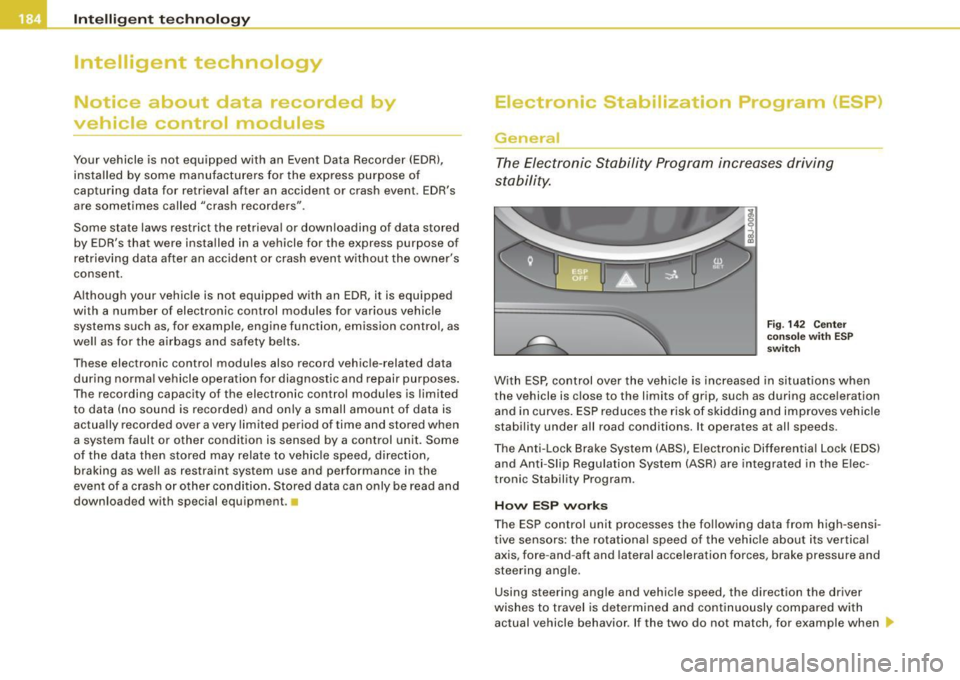
_1--_l_ n _t _ e _ll _,ig ,_,_ e_n _t _ t_ e_ c_ h_n _o_ l_ o ~g""- y.e- __________________________________________ _
Intelligent technology
Notice about data recorded by
vehicle control modules
Your vehicle is not equipped with an Event Data Recorder (EDR),
installed by some manufacturers for the express purpose of
capturing data for retrieval after an accident or crash event . EDR's
are sometimes called "crash recorders".
Some state laws restrict the retrieval or downloading of data stored
by EDR's that were installed in a vehicle for the express purpose of
retrieving data after an accident or crash event w ithout the owner's
consent.
Although your vehicle is not equipped with an EDR, it is equipped
with a number of electronic control modules for various vehicle systems such as, for example, engine function, emission control, as
well as for the airbags and safety belts.
These electronic control modules also record vehic le-related data
during norma l vehicle opera tion for diagnostic and repair purposes .
The recording capacity of the electronic control modules is limited
to data (no sound is recorded) and only a small amount of data is
actually recorded over a very limited period of time and stored when
a system fault or other condition is sensed by a control unit. Some
of the data then stored may relate to vehic le speed, direction,
braking as well as restraint system use and performance in the
even t of a crash or other condition . Stored data can only be read and
downloaded with special equipment.
Electronic Stabilization Program (ESP)
Genel'61
The Electronic Stability Program increases driving
sta bility.
Fig . 142 Cente r
cons ole with ESP
sw itch
With ESP, control over the veh icle is increased in situations when
the vehicle is close to the limits of grip, such as during acce leration
and in curves. ESP reduces the risk of skidding a nd improves vehicle
stability under all road conditions . It operates at all speeds .
The Anti-Lock Brake System (ABS), E lec tronic Differentia l Lock (EDS)
and Anti-Slip Regulation System (ASR) are integrated in the Elec
tronic Stability Program .
H ow ESP work s
The ESP control unit processes the following data from high-sensi
tive sensors: the rotational speed of the vehicle about its vertica l
axis, fore -and -aft and lateral acceleration forces, brake pressure and
steering angle.
Using steering ang le and vehicle speed, the direction the driver
wishes to travel is determined and continuously compared with
actual vehicle behavior . If the two do not match, for example when
Page 188 of 316
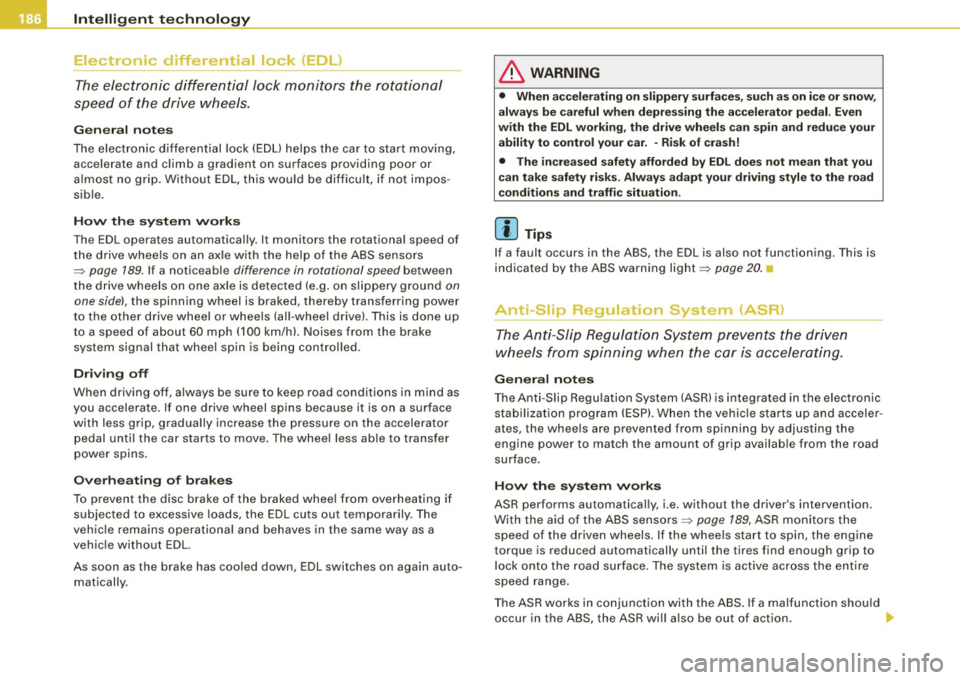
___ ln_ t _e_ ll-'"ig ...,_ e_ n_t _t_ e_ c_ h _ n_o _ l_o _,.g= y,_ __________________________________________ _
Electronic differential lock (EOL)
The electronic differential lock monitors the rotational
speed of the drive wheels.
General notes
The electronic differential lock (EDU helps the car to start moving,
accelerate and climb a gradient on surfaces providing poor or
almost no grip. Without EDL, this would be difficult, if not impos
sible.
How the system works
Th e EDL operates automatically. It monitors the rotational speed of
the drive wheels on an axle with the help of the ABS sensors
=> page 189. If a noticeable difference in rotational speed between
the drive wheels on one axle is detected (e.g. on slippery ground
on
one side),
the spinning wheel is braked, thereby transferring power
to the other drive wheel or wheels (all-wheel drivel. This is done up
to a speed of about 60 mph (100 km/hl. Noises from the brake
system signal that wheel spin is being controlled.
Driving off
When driving off, always be sure to keep road conditions in mind as
you accelerate . If one drive wheel spins because it is on a surface
with less grip, gradually increase the pressure on the accelerator
pedal until the car starts to move. The wheel less able to transfer
power spins.
Overheating of brakes
To prevent the disc brake of the braked wheel from overheating if
subjected
to excessive loads, the EDL cuts out temporarily . The
vehicle remains operational and behaves in the same way as a
vehicle without EDL.
As soon as the brake has cooled down, EDL switches on again auto
matically.
& WARNING
• When accelerating on slippery surfaces, such as on ice or snow,
always be careful when depressing the accelerator pedal. Even
with the EDL working, the drive wheels can spin and reduce your ability to control your car. -Risk of crash!
• The increased safety afforded by EDL does not mean that you
can take safety risks. Always adapt your driving style to the road
conditions and traffic situation.
[ i] Tips
If a fault occurs in the ABS, the EDL is also not functioning . This is
indicated by the ABS warning light=>
page 20. •
Anti-Slip Regulation System (ASR)
The Anti-Slip Regulation System prevents the driven
wheels from spinning when the car is accelerating.
General notes
The Anti-Slip Regulation System (ASR) is integrated in the electronic
stabilization program (ESP). When the vehicle starts up and acceler
ates , the wheels are prevented from spinning by adjusting the
engine power to match the amount of grip available from the road
surface .
How the system works
ASR performs automatically, i.e. without the driver's intervention .
With the aid of the ABS sensors =>
page 189, ASR monitors the
speed of the driven wheels. If the wheels start to spin, the engine
torque is reduced automatically until the tires find enough grip to
lock onto the road surface . The system is active across the entire
speed range.
The ASR works in conjunction with the ABS. If a malfunction should
occur in the ABS, the ASR will also be out of action .
~
Page 230 of 316
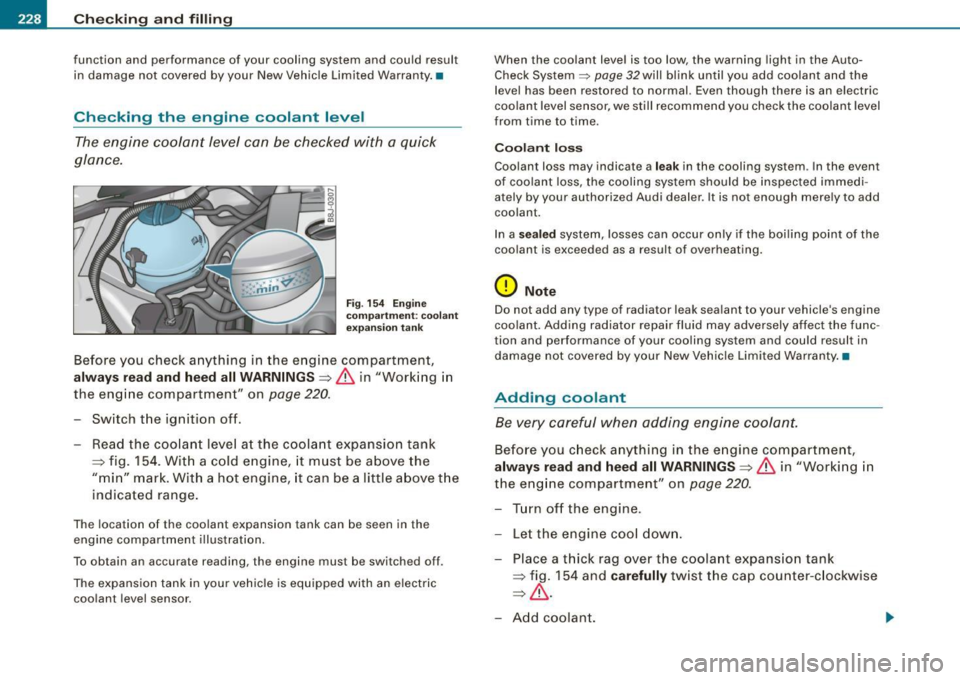
___ C_h_ e_ c_k _in --== g'-- a_n _d_ f_il _li _n ..:::g:::..- ___________________________________________ _
function and performance of your cooling system and could result
in damage not covered by your New Vehicle Limi ted Warranty .•
Checking the engine coolant level
The engine coolant level can be checked with a quick
g lance .
Fig. 154 Engin e
co mpartment : coo lan t
e xpansio n tank
Before you check anything in the engine compartment,
always read and heed all WARNINGS =>
& in "Working in
the engi ne compa rtment" on
page 2 20.
- Switch t he ignition off.
- Rea d the coo lan t leve l at th e co ola nt e xpansion tank
=> fig . 154. Wit h a c old engine , it must be a b ove the
"min" mark . With a hot engine, it can be a little a bove t he
indicated range .
The location of the coo lant expansion tank can be seen in the
engine compartment i llustration.
To obtain an accurate reading, the engine must be switched off .
The expans io n tank in your vehicle is equipped with an electric
coo lant level sensor . When the coolant leve
l is too low , the warning light in the Auto
Check System ~
page 32will blink un til you add coolant and the
level has been restored to normal. Even though there is an electric
coo lant level sensor, we still recommend you check the coolant level
from time to time .
Coolant los s
Coolant loss may indicate a leak in the cooling system . In the event
of coo lant loss, the cooling system should be inspec ted i mmedi
a tely by your authorized Audi dealer . It is no t enough mere ly to add
coolant.
In a
sealed system, losses can occur only if the boi ling point of the
coolant is exceeded as a result of overheating.
0 Note
Do not add any type of radiator leak sea lant to your vehicle's engine
coo lant. A dding ra diator repair fluid may adversely affec t the func
tion and performance of your cooling system and could result in
damage not cove red by your New Veh icle Limi ted War ranty. •
Adding coolant
Be very careful when adding en gine coolant.
Before you c heck anything in the engine compartment,
always read and heed all WARNINGS =>
& in "Working in
the eng ine compa rtment" on
page 220 .
-Turn off the engine.
- Let the engine coo l dow n.
- Place a t hick rag
over th e coola nt expansio n tank
=> fig . 154 and carefully twist the cap cou nter -c lockwise
=> & .
- Add coolant .
Page 253 of 316
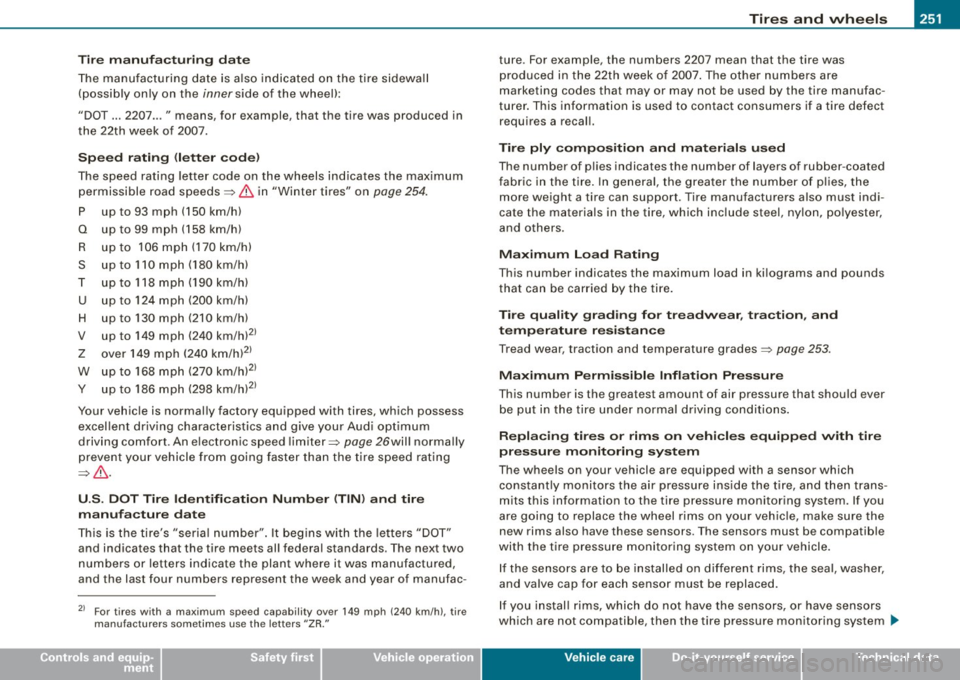
Tires a nd wh eels -
----------------
•
Tire manu fact uring da te
The manufacturing date is a lso indicated on the tire sidewall
(possibly only on the
inner side of the wheell:
"DOT ... 2207 ... " means, for example, that the tire was produced in
the 22th week of 2007.
S peed ratin g (let te r cod e)
The speed rating letter code on the wheels indicates the maximum
permissible road speeds=>
& in "Winter tires" on page 254.
P up to 93 mph (150 km/h)
Q up to 99 mph (158 km/h)
R upto 106mph(170km/h)
S upto110mph(180km/h)
T upto118mph(190km/h)
U up to 124 mph (200 km/h)
H upto 130mph(210km/h)
V up to 149 mph (240 km/h)2>
Z over 149 mph (240 km/h)2>
W up to 168 mph (270 km/h)2>
Y up to 186 mph (298 km/h)21
Your vehicle is normally factory equipped with tires, which possess
excel lent driving characteris tics and give your Audi optimum
driving comfort. An e lectronic speed limiter=> page 26wil l normally
prevent your vehicle from going faster than the tire speed rating
=> & .
U.S . D OT T ire Ident ifi cation Nu mber (TIN ) and tire
m anu fac ture date
This is the tire's "seria l number" . It begins with the letters "DOT"
and indicates that the tire meets all federal standards . The next two
numbers or letters indicate the plant where it was manufactured,
and the last four numbers represent the week and year of manufac-
21 For tires with a maximum speed capability over 149 mph (240 km/h), tire
manufacturers sometimes use the letters "ZR."
ture. For example, the numbers 2207 mean that the tire was
produced in the 22th week of 2007. The other numbers are
marketing codes that may or may not be used by the tire manufac
turer. This information is used to contact consumers if a tire defect
requires a recall.
Tir e ply c omp osition and m aterial s used
The number of plies indicates the number of layers of rubber-coated
fabric in the tire . In general, the greater the number of p lies, the
more weight a tire can support. Tire manufacturers also must indi
cate the materials in the tire, which include steel, nylon, polyester,
and others .
Maximum L oad Rating
This number indicates the maximum load in kilograms and pounds
that can be carried by the tire.
Tir e qu alit y g ra din g for tr eadwear, trac tion, a nd
te mper atu re resi stan ce
Tread wear, traction and temperature grades=> page 253.
Max imum P ermi ssibl e Inf latio n Pre ssure
This number is the greatest amount of air pressure that should ever
be put in the tire under normal driv ing conditions .
Repla cing tires or rims on vehicl es equipp ed with tir e
pres sure monit orin g s yst em
The wheels on your vehicle are equipped with a sensor which
constant ly monitors the air pressure ins ide the t ire, and then trans
mits this information to the tire pressure monitoring system. If you
are going to replace the wheel rims on your vehic le, make sure the
new rims also have these sensors . The sensors must be compatible
with the tire pressu re monitoring system on your vehicle.
I f the sensors are to be installed on different rims, the sea l, washer,
and valve cap for each sensor must be replaced.
If you instal l rims, which do not have the sensors, or have sensors
which are not compatible, then the tire pressure monitoring system ..,_
Vehicle care I t •